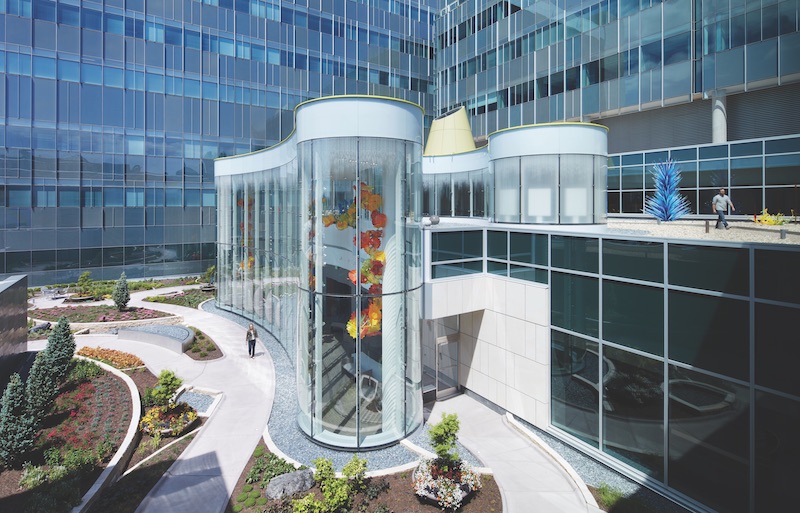In early 2019, the three-story, 80,000-sf SECU Comprehensive Cancer Center is scheduled to open on the campus of CarolinaEast Medical Center, in New Bern, N.C.
The $35 million SECU cancer center—so named for a $3.5 million donation to the project from the North Carolina State Employees Credit Union—will provide radiation oncology, medical oncology, nutrition services, a specialty pharmacy, social worker and psychological services, and a palliative and survivorship program.
CarolinaEast is consolidating cancer treatment and recovery options that currently are scattered across the Tar Heel State’s Craven County. Its new cancer center will be located adjacent to a $15 million diagnostic center, also under construction, which offers imaging services, and where CarolinaEast and UNC Health will provide access to clinical trials, community outreach, and telemedicine.
CarolinaEast Foundation, the nonprofit organization that provides financial support to this health system, declined BD+C’s request for information beyond what’s been reported about the cancer center. But what’s clear is that this new facility reflects an “all in one” design and programming philosophy that is in vogue among healthcare networks.
“Cancer centers are now intended to be one-stop-shop facilities,” says Steve Yanke, PE, LEED AP, Managing Principal with Affiliated Engineers Inc. (AEI), in Phoenix.
One of AEI’s recent projects is the 220,000-sf, $100 million University of Arizona Cancer Center at Dignity Health St. Joseph’s Hospital and Medical Center in Phoenix. Its infusion rooms are more comfortable, quiet, and wired. A full suite of sophisticated diagnostic and treatment equipment stands at the ready. The facility also features a women’s center, patient wellness and support services, a prevention/executive health clinic, and clinical lab space.
 Visitors of the Fred and Pamela Buffett Cancer Center, in Omaha, Neb., take in colorful artwork and sculptures by world-renowned glass artist Dale Chihuly. The multi-level gallery and healing garden, called the Chihuly Sanctuary, is the centerpiece of the 10-story, 615,000-sf cancer center, which includes state-of-the-art equipment and facilities for cancer treatment. Courtesy HDR © 2017 Corey Gaffer.
Visitors of the Fred and Pamela Buffett Cancer Center, in Omaha, Neb., take in colorful artwork and sculptures by world-renowned glass artist Dale Chihuly. The multi-level gallery and healing garden, called the Chihuly Sanctuary, is the centerpiece of the 10-story, 615,000-sf cancer center, which includes state-of-the-art equipment and facilities for cancer treatment. Courtesy HDR © 2017 Corey Gaffer.
Jim Mynott, LEED AP, Vice President of Integrated Design Delivery with McCarthy Building Companies in Los Angeles, notes that even the smallest cancer centers include infusion rooms, Class 10000 clean rooms (the number signifying the particles 0.5 microns or larger permitted per cubic foot of air), and compound labs for mixing isotopes.
In some cases, Mynott adds, cancer centers are attached to medical office buildings that include a retail component for cosmetic products like wigs or clothing.
Indeed, healthcare systems appear to be squeezing as many services and machines as possible into cancer centers, with the only inhibiting factor being the size of the building. For Genesis HealthCare System in Zanesville, Ohio, SmithGroupJJR designed a 50,000-sf cancer center (which opened 18 months ago) with radiation oncology on one floor, medical oncology on another floor, and clinics for exams and infusion separated by an open workspace for the center’s staff. That space is designed to encourage collaboration, and includes 50-sf mini offices with sliding glass doors.
“The goal was to create spaces and experiences that support the patient, their families, and the care staff,” says Simon Bruce, RIBA, Assoc. AIA, Vice President in SmithGroup’s San Francisco office.
 Courtesy HDR © 2017 Corey Gaffer.
Courtesy HDR © 2017 Corey Gaffer.
The 100,000-sf Ann B. Barshinger Cancer Institute, which Ballinger designed for Penn Medicine Lancaster General Health, showcases an interdisciplinary and patient-centric model for cancer care. The building, which was completed in 2015, includes exam and procedure rooms, physician offices, a resource library, conference areas, an image recovery center, infusion center, a renovated and expanded radiation oncology department, a healing garden, a public café, and a meditation room.
The cancer treatment floor within New York Presbyterian’s 734,000-sf David H. Koch Center, scheduled to open later this year, will be patient- and family-centered, too, with radiation and infusion rooms adjacent to communal areas. Patients will have access to support services such as nutrition consults and education on their disease and treatment. Ballinger designed the project in collaboration HOK and Pei Cobb Freed.
 Infusion rooms in cancer centers offer patients different levels of privacy. Pictured: 20 custom-designed infusion pods at Genesis HealthCare System’s Dr. Nick A. & Nancy R. Sarap Cancer Care Center, Zanesville, Ohio. Photo: Brad Feinknopf, Courtesy SmithGroupJJR.
Infusion rooms in cancer centers offer patients different levels of privacy. Pictured: 20 custom-designed infusion pods at Genesis HealthCare System’s Dr. Nick A. & Nancy R. Sarap Cancer Care Center, Zanesville, Ohio. Photo: Brad Feinknopf, Courtesy SmithGroupJJR.
“Cancer centers are being designed with an eye toward more dignity for the patient, and more inclusion for the family,” says Erin Nunes Cooper, AIA, LEED AP, Associate Principal and Senior Project Manager with Ballinger, in Philadelphia. Her firm designs cancer centers for “healing,” with more natural light and views. “Less institutional,” she puts it.
A push for translational research
When HDR was planning the 615,000-sf, $323 million Fred and Pamela Buffett Cancer Center in Omaha, Neb., with the University of Nebraska and Nebraska Medicine, the firm presented those clients with several design examples.
“The one that interested them the most was the ‘under one roof’ model,” particularly University Health Network’s Princess Margaret Cancer Center in Toronto and the Huntsman Cancer Institute in Salt Lake City, Utah, recalls Jon Crane, FAIA, LEED AP, Senior Vice President and Director of Translational Health Services in HDR’s Atlanta office.
Crane explains that the university and healthcare provider wanted to bring together research, clinical, and treatment services, a combination that is less common in the U.S. than elsewhere. So HDR designed this complex, which opened last summer, by locating the cancer center between a hospital and research facility, and situating a new operating center between the hospital and the cancer center.
 The two-story, 100,000-sf Ann B. Barshinger Cancer Institute, an expansion of Penn Medicine’s Lancaster General Health, includes a Meditation Pavilion that looks onto a garden and pond. Photo: © Peter Aaron/Esto.
The two-story, 100,000-sf Ann B. Barshinger Cancer Institute, an expansion of Penn Medicine’s Lancaster General Health, includes a Meditation Pavilion that looks onto a garden and pond. Photo: © Peter Aaron/Esto.
The Buffett Cancer Center is a “hybrid” facility, in that it combines a 10-story, 98-laboratory research tower with an eight-story, 108-bed inpatient treatment tower.
While research/treatment hybrids are typically affiliated with academic hospitals, healthcare systems in general are searching for ways to bring research to the field quicker. This so-called translational research imperative reflects a level of frustration within a healthcare sector where 86% of scientific discoveries never make it out of the lab, according to estimates by Shirley Ryan AbilityLab, a $500 million, 1.2 million-sf facility that opened in Chicago last year as the nation’s first translational hospital.
The ability to get research into the field is “absolutely necessary” in order to keep pace with technological advances, asserts Joseph Saphire, AIA, Principal with Saphire + Albarran Architecture, Pennington, N.J., which has been designing radiation centers for institutions for more than three decades.
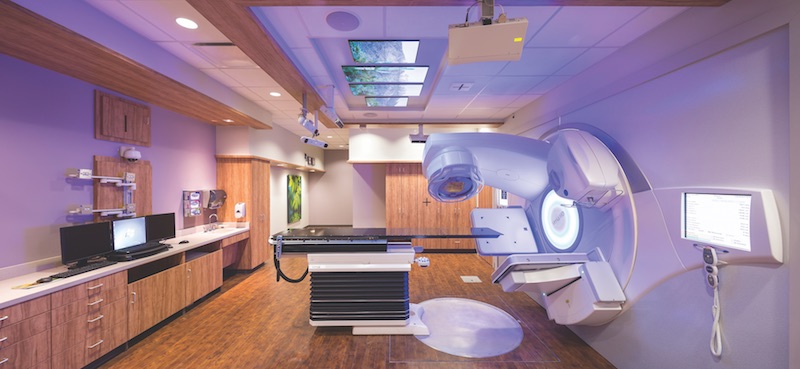 Cancer treatment, more than ever, relies on technology and large diagnostic and treatment equipment that requires special safety measures like eight-foot-thick walls, and a lot more space. Pictured is a Versa HD radiation therapy machine and supporting tech in a treatment room inside Banner MD Anderson Cancer Center in Gilbert, Ariz., which recently added 90,000 sf and renovated 13,000 sf. Photo: ©Blake Marvin Photography.
Cancer treatment, more than ever, relies on technology and large diagnostic and treatment equipment that requires special safety measures like eight-foot-thick walls, and a lot more space. Pictured is a Versa HD radiation therapy machine and supporting tech in a treatment room inside Banner MD Anderson Cancer Center in Gilbert, Ariz., which recently added 90,000 sf and renovated 13,000 sf. Photo: ©Blake Marvin Photography.
The hybrid approach does seem to be catching on, albeit to varying degrees. Last year, E.W. Howell Construction Group completed the 245,000-sf Stony Brook (N.Y.) Hospital Medical and Research Translation (MART) Building and the 225,000-sf Hospital Pavilion. The eight-story MART is devoted to cancer research and care, and is the new home for Stony Brook University’s Cancer Center. The 10-story Hospital Pavilion contains 150 inpatient beds, 12 classrooms, and a 300-seat auditorium.
One of ZGF’s recent projects is the 412,000-sf OHSU Center for Health and Healing that’s scheduled to open in Portland, Ore.’s South Waterfront District in January 2019. Solvei Neiger, AIA, ACHE, Principal with ZGF in Portland, says three floors of that building will be devoted to cancer care, and 2½ floors will provide space for researchers. This building, Neiger explains, is positioned as “a clinical hub,” with 67 exam rooms and 53 infusion chairs. There will also be space where clinical trials are conducted.
Design that anticipates what comes next
The designation “cancer center” is a bit hard to pin down because these facilities vary widely in size and purpose.
The 16 million-sf University of Texas MD Anderson Cancer Center, located at the Texas Medical Center in Houston, might be sui generis when it comes to sheer volume. But other large-scale cancer centers continue to rise up, such as the 2.1 million-sf Kuwait Cancer Center, a freestanding hospital with 600 beds, 16 linear accelerators (LINACs), and dedicated space for radiation oncology, medical oncology, hematoma oncology, and surgical services. The building should be completed by September and start receiving patients by May 2019.
Mike Zorich, PE, LEED AP, Associate Principal with IMEG Corp., which was on that project’s Building Team, explains that as technology becomes more central to cancer care, the added space needed to house diagnostic and treatment equipment is a critical design component.
A parallel trend finds healthcare systems opening smaller satellite cancer centers closer to where patients live, with more selective services and equipment. This branching out is part of some systems’ brand-expansion strategies (see sidebar, page 32).
Regardless of size or location, healthcare systems are asking their AEC partners to design cancer centers for maximum flexibility, to accommodate what many expect will be rapid changes in medicine, treatment, and technology.
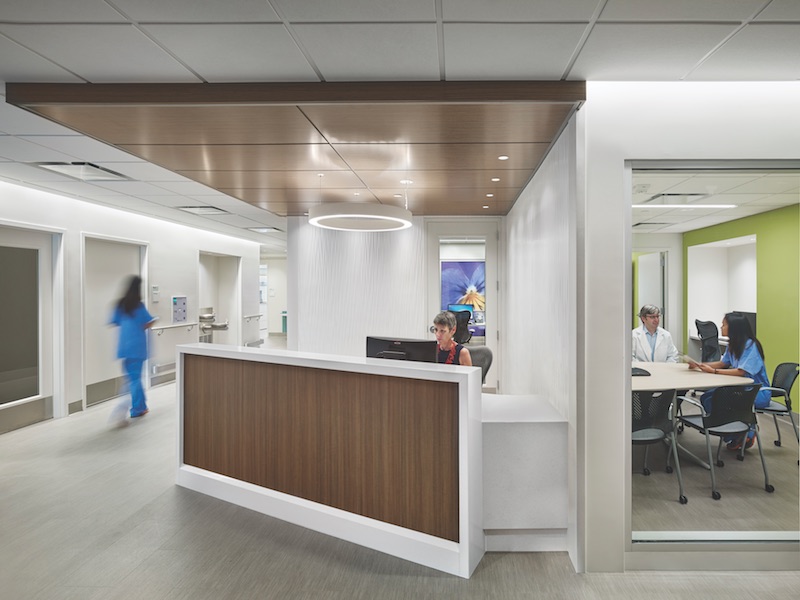 The flexible design of the 25,000-sf, 30-bed MD Anderson Center Center Oncology Inpatient unit at Cooper University Hospital, in Camden, N.J., features “team rooms” that provide privacy and access to patient electronic medical records. Photo: © Haiken/Mason Photography.
The flexible design of the 25,000-sf, 30-bed MD Anderson Center Center Oncology Inpatient unit at Cooper University Hospital, in Camden, N.J., features “team rooms” that provide privacy and access to patient electronic medical records. Photo: © Haiken/Mason Photography.
“The new game is flexibility,” says Andrew Quirk, Senior Vice President and National Director for Skanska USA in Nashville, Tenn., whose career includes stints as an architect with Memorial Sloan Kettering and working on projects for the National Institute of Health.
Quirk notes that clients also want cancer centers that are economical and quicker to build. To that end, Skanska is doing more with prefabricated components for HVAC systems and ducts, which also helps with air quality and cleanliness control.
Flexibility is essential, AEC sources explain, because larger cancer centers can take several years from conception to completion, during which time advances in treatment, technology, and even insurance coverage can outpace the building’s design parameters.
Doss Mabe, FAIA, Partner and Managing Director for ZGF in Los Angeles, estimates that the City of Hope’s new 400,000-sf ambulatory cancer center in Duarte, Calif., for which his firm just completed the schematics, could take five years to complete.
This is the first cancer center that ZGF has designed with on- and off-stage setups for patients and support staffs. And in line with City of Hope’s updated model for care, its clinics will operate five days a week, and be available to physicians who share space with the facility’s staff. “This will make the cancer center more efficient because the rooms don’t have any down days, and will be more sustainable,” Mabe says.
And if circumstances or market forces warrant, this outpatient facility’s design and infrastructure are flexible enough so that it could be converted to something else—a research center, or even a hotel (as City of Hope draws patients from all over the U.S.). Unlikely, but not inconceivable.
Yanke of AEI says that the fifth floor of the University of Arizona’s Cancer Center is set up with shelf space for research. But flexibility has its limits. Originally, this cancer center was going to license half of its fourth floor for ambulatory surgery, but the client ultimately decided against that because the Facility Guidelines Institute’s design and construction guidance calls for rated corridors and entrances that would have added to the project’s costs.
Yanke also notes that making rooms within cancer centers multifunctional is easier said than done, especially when clinical rooms or pharmacies are vented and conditioned differently from research areas.
Giving patients the privacy they want
While there are always new cancer drugs and treatments in the pipeline, chemotherapy isn’t going away any time soon. In line with their demands for flexibility, healthcare systems want infusion rooms to offer patients whatever level of privacy they prefer, from open bays that allow patients to interact, to semi-private and private spaces.
In Louisiana, Thibodaux Regional Medical is gutting an existing outpatient surgery center and turning it into more of an infusion center. The architect, Washer Hill Lipscomb Cabiniss, has redesigned this five-story building with lots of windows and a big atrium down the middle. Its infusion area will be a series of pods whose privacy levels include letting patients control the room’s artificial lighting. “That’s a big deal for a lot of patients,” says Herb Jenkins, PE, Senior Project Manager with Smith Seckman Reid in Nashville, the engineer on the Thibodaux reconstruction.
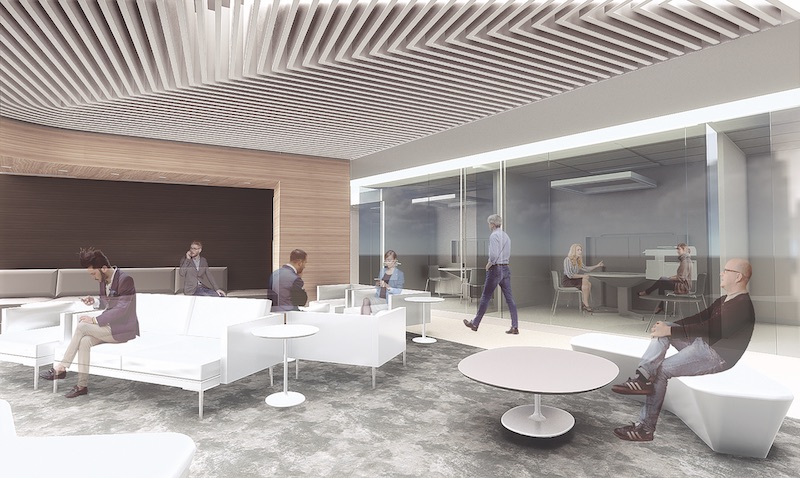 Cedars-Sinai in Los Angeles has several satellite cancer centers in the works or operating in surrounding neighborhoods, including Cedars-Sinai Ventana, a three-story 30,000-sf building in Tarzana, Calif., with infusion and exam rooms, and a hotel-like waiting area with glass-enclosed meeting rooms. ZGF provided architectural, interior design, environmental graphics, and signage. © ZGF.
Cedars-Sinai in Los Angeles has several satellite cancer centers in the works or operating in surrounding neighborhoods, including Cedars-Sinai Ventana, a three-story 30,000-sf building in Tarzana, Calif., with infusion and exam rooms, and a hotel-like waiting area with glass-enclosed meeting rooms. ZGF provided architectural, interior design, environmental graphics, and signage. © ZGF.
McCarthy’s Mynott adds that infusion rooms almost always include TVs, UBS ports, and mobile platforms for sharing patients’ records.
The greater attention being paid to patient comfort is a direct result of the Affordable Care Act, which bases Medicare reimbursements more on patient satisfaction and treatment results. So it’s no longer surprising to hear that a cancer center like Parkview Cancer Institute in Fort Wayne, Ind., a 181,000-sf, six-story replacement outpatient center that is scheduled to open in June, will include among its amenities respite rooms, private spaces for families, palliative care, and an indoor winter garden.
“This is the way cancer centers are headed,” says Jeffrey Stouffer, Global Health Director for HKS in Dallas, which designed this building that will also house 48 infusion bays and four radiation treatment vaults, nutritional and genetic counseling, and a wig boutique. The building is linked to a hospital and MOB via a two-story connector that separates public and staff/service traffic flows.
Treating for recovery or the end of days
This renewed focus on patient comfort reflects an evolving perception of cancer as a long-term but treatable disease.
To be clear, cancer is pervasive. Close to
two-fifths of all Americans will develop cancer in their lifetime. The American Cancer Society estimates that nearly 1.7 million new cancer cases were diagnosed in 2017, a year when more than 600,000 Americans died from cancer, making the disease the second most common cause of death behind heart disease.
The ray of light in those grim statistics is that cancer death rates fell to 161 per 100,000 in 2014, from 215 per 100,000 in 1991, mostly because fewer people smoked. And while the five-year relative survival rate varies by cancer type, over the past three decades it has increased overall by 20% for white Americans and 24% for African-Americans.
Memorial Sloan Kettering’s latest marketing tagline is “More Science. Less Fear.” And some cancer “is no longer viewed as a death sentence,” says Ballinger’s Cooper, echoing comments from other AEC sources. “And that perspective contributes to what we’re asked to do: design spaces that promote healing while supporting patients and families across a full spectrum of cancer care.”
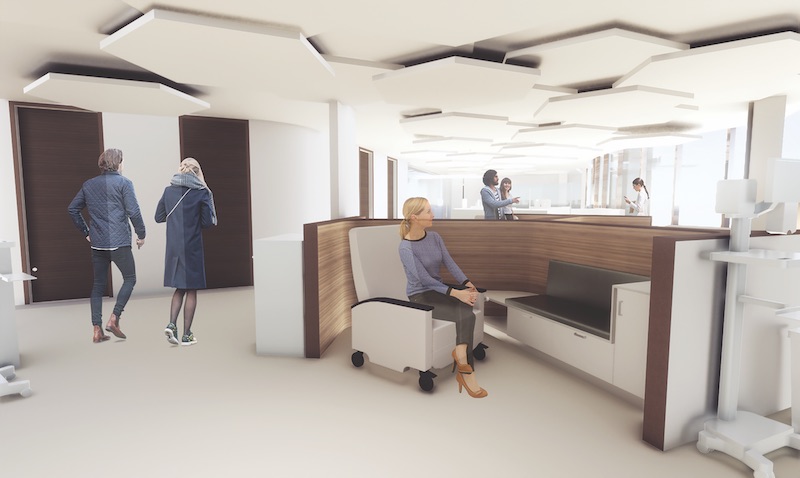 © ZGF.
© ZGF.
Jason Schroer, AIA, ACHE, LEED AP, Director in HKS’s Houston office, adds that because some cancer is viewed as less fatal, “and more about maintenance and continuous care,” his firm’s healthcare clients are thinking harder about what kinds of survivorship and psycho-social services their cancer centers must provide.
But cancer is still lethal for a sizable percentage of patients, and SmithGroupJJR’s Bruce sees a growing trend toward what he calls “complimentary medicine” that combines with palliative care for patients who suffer relapses or are not going to survive their disease. From a design standpoint, Bruce says more cancer centers are including consultation rooms that offer psychological treatment, as well as acupuncture, massage therapy, and nutritional advice to help patients come to terms with death.
Designing for, and around, technology
Technology plays a major role in improving a cancer patient’s chances of survival. And all major cancer centers “are pushing the latest technology,” says HDR’s Crane.
One of IMEG’s recent projects is the Palos Health South Campus in Orland Park, Ill., an 83,000-sf hospital that, when it opens later this year, will include a cancer center with two LINACs, one of which will be MRI-guided. Parkview Cancer Institute will house a 3.0T MRI machine that generates the highest-quality images available.
Firms like IMEG are designing infrastructures to accommodate future technological advances, says Zorich. “Technology is becoming the next big utility, and hospitals need to be ready for it.” Ballinger’s Cooper adds, “What’s exciting for us is how we design a facility that anticipates changes in technology and equipment.”
Designing around cancer-treatment technology, though, is complex. LINACs, which are often paired with PET/CT scanners, have strict shielding requirements that include vaults with six- to eight-foot-thick walls and four- to five-foot-thick ceilings.
Those kinds of physical dimensions are not conducive to remodeling or expansion. Skanska’s Quirk says the trick is figuring out how to add and position equipment so that as few walls as possible need to be moved. Skanska almost always places big diagnostic and radiation therapy machines along exterior walls so they minimally impede a cancer center’s expansion.
Given that 13% of all cancers diagnosed are “rare”—fewer than six cases per 100,000 per year—cancer centers are turning to technology for more specialized and less-invasive treatment options. “The sector is becoming more comprehensive, offering more modalities” that address different types of cancer, says Michael Fahey, Principal in Charge for the Proton Therapy Group within Bard, Rao + Athanas Consulting Engineers (BR+A) in New York.
Among BR+A’s recent projects is the 63,000-sf Texas Center for Proton Therapy in Irving, which opened in May 2016, and features “pencil-beam” scanning for more precise radiation treatment; and the 90,000-sf Proton Therapy Center at Cincinnati Children’s Hospital/UC Health, which opened in September 2016.
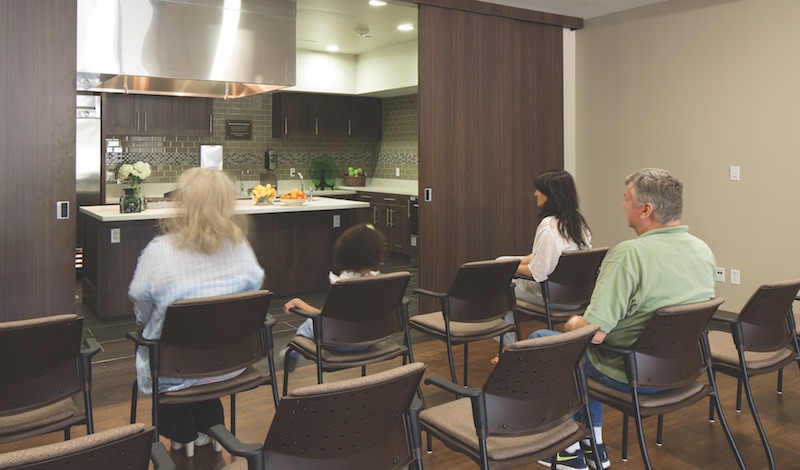 As some cancer is seen as treatable, wellness is becoming a bigger part of cancer care. Texas Health Presbyterian Hospital Dallas Cancer Center includes a dietary education kitchen, as well as access to programs for yoga, Thai Chi, and art therapy. Photo: Daniel Shields, HKS.
As some cancer is seen as treatable, wellness is becoming a bigger part of cancer care. Texas Health Presbyterian Hospital Dallas Cancer Center includes a dietary education kitchen, as well as access to programs for yoga, Thai Chi, and art therapy. Photo: Daniel Shields, HKS.
BR+A is also on the Building Team for the three-story, 115,300-sf Proton Therapy Center in Harlem, which had been in development for eight years. The center’s oncology and operations team, comprised of Memorial Sloan Kettering, Mount Sinai, Montefiore Health System, and ProHealth Proton Management, expects this center to start accepting patients by February 2019. The New York Times reports that two-fifths of this project’s final price tag—which it estimates at more than $300 million—will go toward equipment that includes an 80-ton cyclotron.
The Harlem center—the first of its kind in the state of New York—is among 11 proton therapy centers under construction in the U.S., where 25 proton therapy centers already operate.
Home treatment on the horizon
The challenge for healthcare systems will continue to be keeping up with technological changes. Fahey predicts that carbon-ion therapy, which is already being used in Germany and Japan, could be the next big radiation treatment in the U.S. He and other AEC sources also foresee genetic research and immunotherapy playing even more important roles in cancer care, as well as cancer centers being more involved in clinical trials.
How cancer is addressed in the future, however, is just as likely to be impacted by less-expensive, subtler solutions.
Yanke of AEI notes that the University of Arizona’s Cancer Center includes a demonstration kitchen where patients learn to cook healthier foods. The Buffett Cancer Center’s “healing program” includes a glass-enclosed sanctuary and an outdoor all-season garden.
Amenities like these lead Schroer and Stouffer of HKS to infer that the healthcare sector is on the cusp of blending cancer care with prevention and wellness, which might mix everything from psychological counseling and education to acupuncture and massage therapy. “There’s huge potential here, especially for satellite cancer centers,” agrees SmithGroupJJR’s Bruce.
Another game changer could be telemedicine, not only in the way patients communicate with caregivers, but also how medical professionals and staff of various healthcare systems exchange research and knowledge with no borders.
Telemedicine is expanding the capacity of healthcare systems to reach patients in rural or far-flung areas who don’t have convenient access to hospitals or clinics.
Neiger of ZGF foresees more patient care being administered outside of clinical or treatment facilities, where a nurse would come to a patient’s house to determine what treatment might be required before that patient treks to a cancer center.
Will doctors start making house calls again? That might seem farfetched. But Skanska’s Quirk can envision technology—especially wearables—reaching a point of precision where cancer patients are not only diagnosed from their homes, but in some cases are treated there, too. Such an evolution in cancer care “would have major implications on what gets built,” says Quirk.
Related Stories
Healthcare Facilities | Apr 16, 2024
Mexico’s ‘premier private academic health center’ under design
The design and construction contract for what is envisioned to be “the premier private academic health center in Mexico and Latin America” was recently awarded to The Beck Group. The TecSalud Health Sciences Campus will be located at Tec De Monterrey’s flagship healthcare facility, Zambrano Hellion Hospital, in Monterrey, Mexico.
Healthcare Facilities | Apr 11, 2024
The just cause in behavioral health design: Make it right
NAC Architecture shares strategies for approaching behavioral health design collaboratively and thoughtfully, rather than simply applying a set of blanket rules.
Healthcare Facilities | Apr 3, 2024
Foster + Partners, CannonDesign unveil design for Mayo Clinic campus expansion
A redesign of the Mayo Clinic’s downtown campus in Rochester, Minn., centers around two new clinical high-rise buildings. The two nine-story structures will reach a height of 221 feet, with the potential to expand to 420 feet.
Products and Materials | Mar 31, 2024
Top building products for March 2024
BD+C Editors break down March's top 15 building products, from multifamily-focused electronic locks to recyclable plastic panels.
Healthcare Facilities | Mar 18, 2024
A modular construction solution to the mental healthcare crisis
Maria Ionescu, Senior Medical Planner, Stantec, shares a tested solution for the overburdened emergency department: Modular hub-and-spoke design.
Healthcare Facilities | Mar 17, 2024
5 criteria to optimize medical office design
Healthcare designers need to consider privacy, separate areas for practitioners, natural light, outdoor spaces, and thoughtful selection of materials for medical office buildings.
Healthcare Facilities | Mar 15, 2024
First comprehensive cancer hospital in Dubai to host specialized multidisciplinary care
Stantec was selected to lead the design team for the Hamdan Bin Rashid Cancer Hospital, Dubai’s first integrated, comprehensive cancer hospital. Named in honor of the late Sheikh Hamdan Bin Rashid Al Maktoum, the hospital is scheduled to open to patients in 2026.
Sports and Recreational Facilities | Mar 14, 2024
First-of-its-kind sports and rehabilitation clinic combines training gym and healing spa
Parker Performance Institute in Frisco, Texas, is billed as a first-of-its-kind sports and rehabilitation clinic where students, specialized clinicians, and chiropractic professionals apply neuroscience to physical rehabilitation.
Healthcare Facilities | Mar 7, 2024
A healthcare facility in New Jersey will be located at a transit station
The project is part of a larger objective to make transportation hubs more multipurpose.
University Buildings | Feb 21, 2024
University design to help meet the demand for health professionals
Virginia Commonwealth University is a Page client, and the Dean of the College of Health Professions took time to talk about a pressing healthcare industry need that schools—and architects—can help address.


